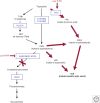Integration of light and auxin signaling
- PMID: 20457562
- PMCID: PMC2882117
- DOI: 10.1101/cshperspect.a001586
Integration of light and auxin signaling
Abstract
Light is vital for plant growth and development: It provides energy for photosynthesis, but also reliable information on seasonal timing and local habitat conditions. Light sensing is therefore of paramount importance for plants. Thus, plants have evolved sophisticated light receptors and signaling networks that detect and respond to changes in light intensity, duration, and spectral quality. Environmental light signals can drive developmental transitions such as germination and flowering, but they also continuously shape development to allow adaptation to the local habitat and microclimate. The ability to respond to a changing and sometimes unfavorable environment underlies the huge success of plants. Much of this growth and developmental plasticity is achieved by light modulation of auxin signaling systems. In this article, we examine the connections between light and auxin that elicit local responses, long distance signaling, and coordinated growth between the shoot and root.
Figures


Similar articles
-
PIFs get BRright: PHYTOCHROME INTERACTING FACTORs as integrators of light and hormonal signals.New Phytol. 2014 Jun;202(4):1126-1141. doi: 10.1111/nph.12725. Epub 2014 Feb 26. New Phytol. 2014. PMID: 24571056 Review.
-
Shedding light on auxin movement: light-regulation of polar auxin transport in the photocontrol of plant development.Plant Signal Behav. 2013 Mar;8(3):e23355. doi: 10.4161/psb.23355. Epub 2013 Jan 18. Plant Signal Behav. 2013. PMID: 23333970 Free PMC article. Review.
-
Light and auxin signaling cross-talk programme root development in plants.J Biosci. 2019 Mar;44(1):26. J Biosci. 2019. PMID: 30837377 Review.
-
HY5 and phytochrome activity modulate shoot-to-root coordination during thermomorphogenesis in Arabidopsis.Development. 2020 Dec 15;147(24):dev192625. doi: 10.1242/dev.192625. Development. 2020. PMID: 33144393 Free PMC article.
-
The interplay between extracellular and intracellular auxin signaling in plants.J Genet Genomics. 2025 Jan;52(1):14-23. doi: 10.1016/j.jgg.2024.06.019. Epub 2024 Jul 3. J Genet Genomics. 2025. PMID: 38969259 Review.
Cited by
-
Transcriptome analysis of shade-induced inhibition on leaf size in relay intercropped soybean.PLoS One. 2014 Jun 2;9(6):e98465. doi: 10.1371/journal.pone.0098465. eCollection 2014. PLoS One. 2014. PMID: 24886785 Free PMC article.
-
Nitric Oxide, Ethylene, and Auxin Cross Talk Mediates Greening and Plastid Development in Deetiolating Tomato Seedlings.Plant Physiol. 2016 Apr;170(4):2278-94. doi: 10.1104/pp.16.00023. Epub 2016 Feb 1. Plant Physiol. 2016. PMID: 26829981 Free PMC article.
-
Epidermal Phytochrome B Inhibits Hypocotyl Negative Gravitropism Non-Cell-Autonomously.Plant Cell. 2016 Nov;28(11):2770-2785. doi: 10.1105/tpc.16.00487. Epub 2016 Oct 6. Plant Cell. 2016. PMID: 27758895 Free PMC article.
-
Bacillus amyloliquefaciens GB03 augmented tall fescue growth by regulating phytohormone and nutrient homeostasis under nitrogen deficiency.Front Plant Sci. 2022 Oct 6;13:979883. doi: 10.3389/fpls.2022.979883. eCollection 2022. Front Plant Sci. 2022. PMID: 36275534 Free PMC article.
-
A DAO1-Mediated Circuit Controls Auxin and Jasmonate Crosstalk Robustness during Adventitious Root Initiation in Arabidopsis.Int J Mol Sci. 2019 Sep 9;20(18):4428. doi: 10.3390/ijms20184428. Int J Mol Sci. 2019. PMID: 31505771 Free PMC article.
References
-
- Ang LH, Chattopadhyay S, Wei N, Oyama T, Okada K, Batschauer A, Deng XW 1998. Molecular interaction between COP1 and HY5 defines a regulatory switch for light control of Arabidopsis development. Mol Cell 1:213–222 - PubMed
-
- Bhalerao RP, Eklof J, Ljung K, Marchant A, Bennett M, Sandberg G 2002. Shoot-derived auxin is essential for early lateral root emergence in Arabidopsis seedlings. Plant J 29:325–332 - PubMed
-
- Bou-Torrent J, Roig-Villanova I, Martinez-Garcia JF 2008. Light signaling: Back to space. Trends Plant Sci 13:108–114 - PubMed
-
- Canamero RC, Bakrim N, Bouly JP, Garay A, Dudkin EE, Habricot Y, Ahmad M 2006. Cryptochrome photoreceptors cry1 and cry2 antagonistically regulate primary root elongation in Arabidopsis thaliana. Planta 224:995–1003 - PubMed
Publication types
MeSH terms
Substances
Grants and funding
LinkOut - more resources
Full Text Sources
